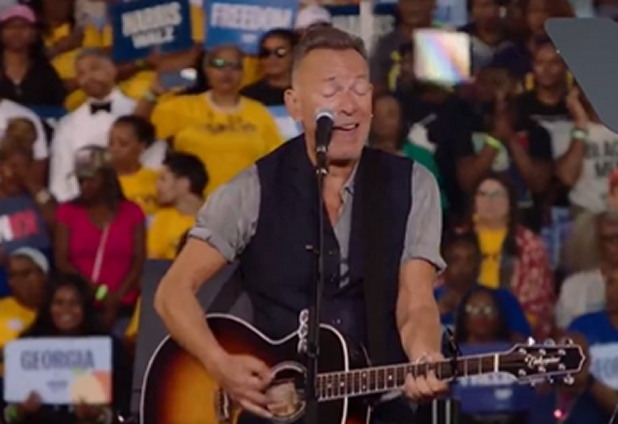The recent rally for Kamala Harris in Georgia was intended to be a star-studded event, primarily highlighted by the performance of beloved rock icon Bruce Springsteen. The anticipation built by Harris’s campaign and widespread media attention suggested that this appearance would bolster her profile and energize supporters leading up to critical elections. However, what unfolded during Springsteen’s performance was far from the expectations created by the hype. Instead of galvanizing the crowd, his rendition of “Dancing in the Dark,” a classic hit from the 1980s, was met with dismay as many described it as underwhelming and poorly executed.
The performance, which was meant to resonate with a crowd eager for motivation, instead left listeners in disbelief. Critics and fans alike expressed shock at Springsteen’s faltering vocals and lackluster guitar playing. Some viewers even remarked that it felt as though they were watching a poor imitation of the artist rather than the real Bruce Springsteen. The discrepancy between what was promised and what was delivered sparked a wave of negative commentary across social media platforms. Listeners described the event as “an abomination” and pondered whether there was a strategy behind such a sluggish performance.
As the rally progressed, Springsteen’s performance quickly became the focal point for ridicule rather than a moment of unity or inspiration for Harris’s supporters. People had gathered in hopes of seeing the legendary musician elevate the atmosphere, yet the experience was marked by confusion and frustration instead. Twitter reactions showcased a barrage of critical remarks, with many expressing disbelief at how Springsteen, once synonymous with powerful performances, could deliver such a disjointed act. The disconnect created by this performance was palpable, overshadowing the political messages meant to resonate during the rally.
Commentators could not help but reflect on the dramatic fall from grace displayed in Springsteen’s performance. The disheartening feedback illuminated the stark reality that even esteemed artists have off days, prompting discussions about the pressures performers face and the impact of public expectations. The singer’s struggle with his own song—a tune that had brought him significant acclaim—became emblematic of the larger struggles political campaigns face when trying to engage audiences. Ultimately, Bruce Springsteen’s lackluster performance seemed to complicate the narrative Harris’s campaign was attempting to orchestrate, as the rally participants were left grappling with mixed emotions.
Ironically, one of the lines from “Dancing in the Dark” resonated chillingly in this context: “There’s a joke here somewhere and it’s on me.” This sentiment seemed to epitomize the overall tone of disbelief permeating through the crowd and online discussions post-performance. It underscored a disconnect not only with Springsteen’s presentation but also served as a reflection on something deeper within the event itself. Such occurrences can undermine even the most carefully curated political gatherings, where entertainment is employed to invigorate and engage a crowd.
In conclusion, the disastrous performance by Bruce Springsteen at Kamala Harris’s rally serves as a reminder of just how critical delivery and execution are in tethering the aspirations of a political campaign with audience engagement. While the campaign aimed to position itself advantageously by showcasing a cultural icon, the result led to disappointment instead. This misfire highlights the vulnerability that comes from intertwining politics with celebrity endorsements, as the narrative can swiftly turn from uplifting to embarrassing. The aftermath of the performance remains a talking point, igniting conversations about the relationship between political figures and the artists they enlist to support their causes.

